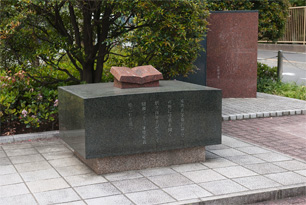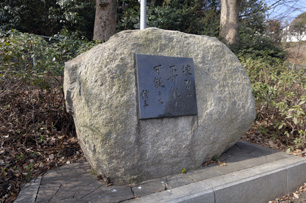Keio Art Square (5)
Monument of the birthplace of Keio University (Yoshiro Taniguchi)
Unveiled on 23 April, 1958 (school anniversary)

The origin of Keio University is a private school for Dutch studies which Yukichi Fukuzawa opened in 1858 inside the residence of the Okudaira family of Nakatsu Domain. The "Monument of the birthplace of Keio University", designed by Yoshiro Taniguchi who designed many building for Keio University, was built on the 100th anniversary of Keio University. It is built in front of St. Luke's International Hospital in Akashi-cho, Chuo-ku, Tokyo, near the site where Fukuzawa opened his private school. Coincidentally, this is also the site where the translation of Tafel Anatomie, an anatomy textbook, was started by a group of people including Ryotaku Maeda who was a doctor for the Nakatsu Domain. The "Monument of the birthplace of western studies in Japan" was built in honor of this achievement. The two monuments are known as the "Monuments of the beginning of Japan's modern culture".
Stone monument "Practice makes the impossible possible"

Former President Shinzo Koizumi, who was a player of the Keio University tennis team when he was a student, and became manager of the team after graduation and contributed to the development of the team. The stone monument facing the tennis court in Mamushidani of Hiyoshi Campus was built in 1967, a year after the passing of the former President. The phrase "Practice makes the impossible possible", which was engraved using his brushwork, is a message based on "furious practice beyond explanation" which he experienced himself during his college days. This advice, which is widely known even beyond Keio University, still keeps telling people the importance of devoting continuous efforts.
